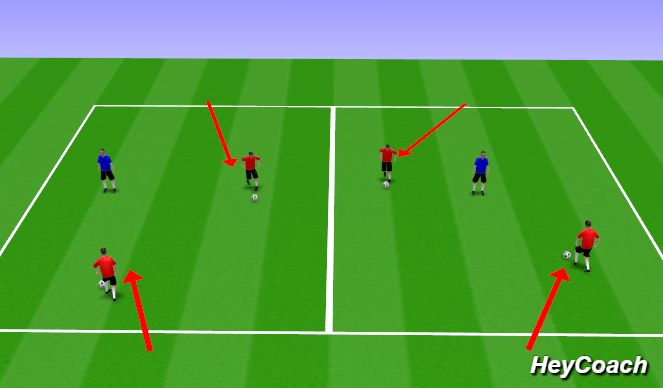
Organization:
1. 20 x 20 yard area set up as shown
2. 12 players set up as shown
3. 1 ball per player
Instructions:
1. All players dribble around the area
2. On coach’s call “switch”, players stop their ball from moving, and start dribbling with a new ball (see A )
3. One ball is removed every 30 seconds, leaving one more player without a ball each time
4. Players without a ball must try to steal one from another player
5. If a ball is stolen, that player must steal one from a different person
6. Play for set time period
Coaching Points:
1. Change of speed and direction
2. Head up, accelerate away
Progressions:
1. P – Coach can restrict the surfaces players may use to control the ball, e.g. inside only, outside only, soles only
2. P – Players can steal the ball back from the person who stole it from them , immediately
3. R – Add in more balls than players

Organization:
1. 20 x 10 yard area set up as shown
2. 3 players (2 Attackers, 1 Defender) set up as shown
3. 1 ball per player
Instructions:
1. Attacking players start at opposite ends of area
2. Each attacker starts dribbling tow ard opposite end of area simultaneously
3. Defender must try to stop players from reaching opposite end
4. Attackers score one point for each successful run across area
5. If defender dispossesses attacker, and keeps ball in grid, they switch roles
6. First player to 10 points wins
Coaching Points:
1. Controlled approach
2. Know when to run with the ball and when to dribble
3. Engage defender at speed by attacking front foot
4. Timing of move – just outside tackling radius
5. Change of speed and direction
6. Cut into the space behind defender
Progressions:
1. P – Both attackers start from the same end line, and attack the same end
2. R – Defender must stay in the middle for 10 repetitions, even if they win the ball

Organization:
1. 40 x 10 yard area set up as shown
2. 6 players (3 Attackers, 3 Defenders) set up as shown
3. Markers indicating lines 10 yards apart
4. 1 ball per attacker
Instructions:
1. Defending players start on a line each, and may not move off this line
2. Attackers must negotiate all three defenders and dribble past end line to score
3. If attacker is dispossessed, they go back to the start line
4. Next attacker can start run when second defensive line has been passed
5. Attackers get 4 repetitions each before switching roles
Coaching Points:
1. Controlled approach
2. Engage defender at speed by attacking front foot
3. Timing of move – just outside tackling radius
4. Change of speed and direction
5. Cut into the space behind defender
Progressions:
1. P – Distance between defensive lines can be reduced to 6 yards
2. R – Middle defender can be removed to leave two defenders 20 yards apart. Spare defender becomes an extra attacker

Organization:
1. 50 x 30 yard area set up as shown
2. 12 players (Teams of 6) set up as shown
3. 1 ball (Additional balls situated around the outside)
Instructions:
1. Team starts with kick off from center of field
2. Teams score by shooting into the center goal, worth 2 points (see A), or by dribbling through either wide gate, worth 1 point (see B)
3. If ball goes out, team restarts with a pass or dribble in
4. If goal is scored, conceding team restart w ith a kick off from center of field
Coaching Points:
1. Controlled approach
2. Engage defender at speed by attacking front foot
3. Timing of move – just outside tackling radius
4. Body shape – low centre of gravity
5. Change of speed and direction
6. Cut into the space behind defender
Progressions:
1. P – Wide gates are removed, and only the central gates score points
2. R – Increase wide gates to 3 yards wide
3. R – Make first touch free for attacking team , when restarting play from a kick in